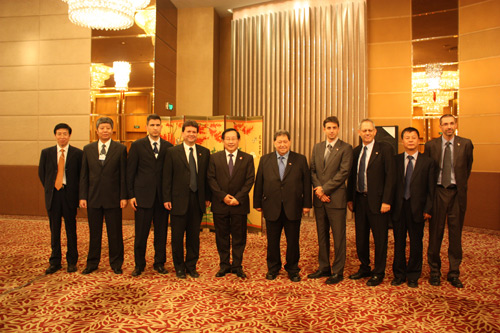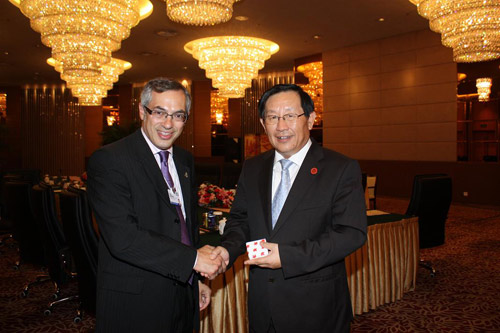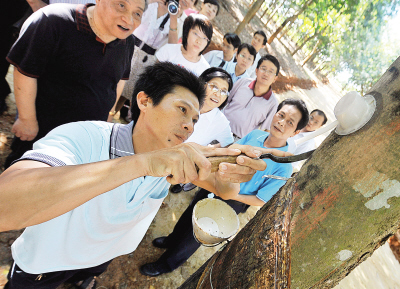CHINA SCIENCE AND TECHNOLOGY
NEWSLETTER
The Ministry of Science and Technology
People's Republic of China
|
|
|
N0.596 |
September 30, 2010 |
|
|
|
|
|
|
|
|
IN THIS ISSUE
|
|
* WAN Met with Israeli Guests
*WAN Met with Canadian Guests
*China-Swiss Joint Working Group Meeting
* Genetic Mutation Found in Non-Smoking Patients
*Land Cover Map for South Pole
*Modern Polar Expedition Fleet
*China's Installed Capacity Hits 900 Million Kilowatts
|
|
INTERNATIONAL COOPERATION |
WAN Met with Israeli Guests

On September 13, WAN Gang, Chinese Minister of Science and Technology met with Binyamin Ben-Eliezer, Israeli Minister of Industry, Trade and Labor and his party who attended Summer Davos Annual Meeting in Tianjin. Both sides exchanged views on industrial collaborations between the two countries, and agreed to enhance the implementation of the technology innovation accord signed between the two countries in May this year, in a move to raise the innovation capability and competitiveness of industrial enterprises. WAN pointed out that promoting R&D cooperation meets both countries’ requirements for development and their national interests, hoping that phase I projects can be rolled out under the innovation accord within the year.
Binyamin Ben-Eliezer said both countries should strengthen cooperation in the area of water resources, agriculture, biotechnology, and medicine. He added that Israel welcomes Chinese enterprises visiting Israel, deepening their understanding of Israel, and broadening the fields of cooperation. Israeli Minister also said that the fruitful cooperation between Israel and Chinese enterprise in Jiangsu Province makes a role model for such cooperation. The two parties also discussed possible collaborations in the areas of innovative processes and petroleum substitutes.
WAN Met with Canadian Guests

WAN Gang, Chinese Minister of Science and Technology met with Tony Clement, Canadian Minister of Industry and his party who attended Summer Davos Annual Meeting in Tianjin on September 14, 2010. Both Parties thought highly of the cooperation between the two countries in the areas of energy, environment, health, agriculture among others, since an intergovernmental S&T cooperation accord inked between the two countries, hoping that more enterprises will be part of the cooperation. Wan said two countries will strengthen the collaboration in the area of new energy vehicles, suggesting that Canada be part of the ‘Electric Car Initiative’ proposed by both China and the United States. Clement briefed the other side of R&D activities made by Canadian companies in China, and expressed willingness to enhance cooperation with China in the areas of new energy, agriculture, civil aviation, and other priority areas of common interest, and to promote the bilateral cooperation in the area of electric vehicles.
CAO Met with Danish Guests
CAO Jianlin, Chinese Vice-Minister of Science and Technology met with Charlotte Sahl-Madsen,Danish Minister for Science, Technology and Innovation and her party on September 13, 2010 in Shanghai. Both sides believe that they should strengthen scientific and technological cooperation in the future.
Cao said scientific and technological cooperation between the two countries is built on a broad base, and is complementary to one another. The exchange between the universities of two countries sets up a good example for reaching out between the two countries having different cultural backgrounds, hoping both China and Denmark will strengthen S&T cooperation in the future, promoting the development of strategic and emerging industries in the two countries.
Sahl-Madsen said efforts have been made to strengthen scientific and technological cooperation between the two countries in recent years. The two governments signed an agreement in April 2010 to officially launch a project for establishing a joint research and education center, facilitating exchanges of researchers. The two countries also saw fruitful cooperation in the field of renewable energy, which plays an important role in promoting the economic collaborations between the two countries. Sahl-Madsen added that her visit to China is meant to deepen bilateral cooperation in the areas of education and scientific research.
The two delegations met at a joint intergovernmental committee meeting held on September 16, 2010 in Changzhou to discuss the priority areas of scientific and technological cooperation between the two countries in the future, making arrangements for next phase collaborations and associated implementation.
China-Swiss Joint Working Group Meeting
The 5th China-Swiss joint working group meeting on science and technology was held on September 10, 2010 in Beijing. XU Chaoqian, MOST Deputy Director of International Cooperation and Juerg Burri, Deputy Director, Swedish State Secretariat for Education and Research, co-chaired the meeting. Both sides briefed the other side of the latest S&T developments in their countries, and the progresses made in the areas of energy, resources, environment in recent years, especially under the impact of financial crisis. XU said Sino-Swiss Science and Technology Cooperation Plan for 2008-2011 (SSSTC) opened a new page in S&T cooperation between the two countries. Both Chinese and Swiss governments secured firm support for 30 high quality projects, allowing them to be implemented in a smooth manner, and to become a role model for China-EU S&T cooperation.
Burri introduced the innovation system and research funding mechanisms in Switzerland, hoping Chinese and Swiss research institutes working together for mutual benefits. The two sides also shared vision of the future strategic positioning of S&T cooperation between the two countries, and exchanged views on deepening the bilateral cooperation in a targeted, phased, and priority-set manner. The two sides confirmed life sciences and biotechnology, advanced manufacturing, and materials science the main cooperation areas. Both sides also agreed to scale up funding for research projects when budget permits.
Young Scientists Exchange Program
A young scientists exchange program between China and Australia for 2010 was kicked off on September 13 in Beijing. Officials from MOST Department of International Cooperation, National Natural Science Foundation, and Chinese Academy of Sciences, spoke at the meeting about S&T cooperation between the two countries and relevant international cooperation projects initiated by under the cooperation. 8 Australian scientists and the representatives from Tsinghua University and CAS Institute of Chemistry, were also present at the event.
The exchange program was jointly initiated by Chinese Ministry of Science and Technology and Australian Ministry for Education, Science and Training in April 2006 when Chinese Premier WEN Jiabao visited Australia, in an attempt to promote exchanges between young scientists, enhancing mutual understanding and friendship, encouraging them to be part of bilateral S&T cooperation, and laying a foundation for the long-term cooperation between the two countries. Each year each country would select eight outstanding young scientists in the priority areas to visit the other country for two weeks.
Genetic Mutation Found in Non-Smoking Patients
JI Hongbin, a research fellow working at CAS Shanghai Institutes for Biological Sciences, in collaboration with Professor Chen Haiquan of Fudan University Tumor Hospital, studied genetic mutations appeared in the tumor samples collected from non-smoking lung cancer patients, taking advantage of a high-quality lung cancer sample database. The study results show that in 52 cases of non-smoking lung cancer patients, 90% have shown the cancer-causing genetic mutations or fusions. 41 patients showed EGFR kinase mutation, with 2 patients having mutations in HER2 kinase, 3 patients showing EML4-ALK genetic fusion, and 1 patient having KRAS mutation.
The finding is the first report of cancer-causing genetic mutation in non-smoking lung cancer patients in the world, which creates a theoretical basis and guidance for individualized lung cancer treatments. At present, there are some small molecule drugs that are clinically available for inhibiting the activity of mutant EGFR, HER2, and ALK. The finding, published in the recent issue of Clinical Oncology, shows that non-smoking lung cancer patients can be benefited from the small molecule drugs.
Budding Based Sapling Crafting Technique

Stimulation tapping.
Thanks to 20-odd year’s efforts, researchers at Chinese Academy of Tropical Agriculture worked out a budding based rubber tree sapling crafting technique. Researchers improved a range of processes before making the desired technique a success, including seeds storage, budding grafting, culture medium making, breeding container making, fixation, and breeding environment. The new technique makes a gratifying solution to addressing the problems of short budding grafting time, low success rate, large medium needs, and inconvenient fixation commonly seen in budding grafting.
Land Cover Map for South Pole
With the support of National 863 Program, Chinese scientists have successfully produced a land cover map at a scale of 1:100,000 for the South Pole, the first of its kind in the world. The map shows important scientific data collected by Chinese scientists from Antarctica.
Prof. CHENG Xiao, Vice President of Beijing Normal University Institute of Global Change and Earth System said at an annual meeting on China’s polar activities in 2010 that Chinese scientists have collected more than 1,100 satellite images of Antarctica during the period 1999-2003. These images have been turned into real surface elements in the pole, and a six-band ETM + mosaic map with a resolution of 15 meters, thanks to the application of a range of advanced technologies, including DN saturation and overflow tuning, radiometric correction, and surface reflectivity conversion.
At the same time, researchers established a land cover classification system for the pole, including blue ice, crack, bare rock, water body, ice moraine, and firn. They interpret land cover using the ETM + mosaic map. Researchers also validated the results derived from the ETM + mosaic map through a range of on-site measurements made during China's 25th and 26th Antarctic expeditions.
Data shows that Antarctic coastlines run 39,266 km long, encircling an area of 13.622915 million square kilometers. There are 1,169 islands that are larger than 15,000 square meters in area. Firn makes the dominant land cover in the Pole, with cracks and blue ice mainly distributed along the coasts and bare rocks (except the Antarctic Peninsula). Ice moraine mainly sits around bare rocks. Water bodies usually find expression in lakes and rivers. Ice-surface lakes can be spotted mainly in the Antarctic Peninsula, Ross Ice Shelf, and Mac Robertson Land. Bare rocks are mostly seen in Antarctic mountain range, Ellsworth Mountains, Grove Hill, Prince Charles Mountains, and the Antarctic Peninsula.
China’s New Station in South Pole
It is disclosed from an annual meeting held to discuss China’s polar activities in 2010 that China will enhance its polar exploration capacity, using high technologies, and enhancing logistic support capability during the period of 2011-2015. China will establish a new research station in the main area of the Pole during the period of 2015-2025.
China's Great Wall Station and Zhongshan Station in Antarctica have been frequently used by Chinese scientists. In addition to advanced communication equipment and comfortable living conditions, the stations have been equipped with advanced laboratories and scientific instruments. In a normal year, some 40 scientists would work at Great Wall Station throughout the winter, and approximately 80 scientists would visit the station in the summer. Zhongshan Station accommodates fewer people, with 25 in the winter, and 60 in the summer. China established a Kunlun station in the Dome A region in 2009. Kunlun station is currently a summer station, though it will be turned to accommodate winter visitors in the future.
From the 12th Five-year period (2011-2015) and on, China will strengthen the construction of polar scientific research base, expanding survey scope, establishing well functioned transportation system, emergency management system, communication network, and information sharing system for safe and fruitful research activities in the polar regions.
Modern Polar Expedition Fleet
China plans to build a new ice breaker for polar expedition activities, in addition to "Snow Dragon" polar scientific research boat. According to a plan, the new icebreaker will be built starting from 2011, and put into operation in 2013. The new icebreaker will work with "Snow Dragon" for polar research activities. They can also be grouped with other marine vessels into a modern polar fleet serving different research needs.
The new icebreaker will be jointly designed by renowned ice breaker designers, and built by domestic manufacturers. It will be designed with an ice-breaking capacity up to 1.5 meters, an 8,000-ton tonnage, and a cruising capability for 18,000 sea miles. It will house 90 people, with a self-sustaining capability for 60 days. Running at a speed of 12 knots with the maximum speed up to 16 knots, the icebreaker can survive a strong wind up to 52 m /s, and work under an ambient temperature up to -35 ℃. The boat will be equipped with two small power generators, and able to accommodate a small helicopter.
China's Installed Capacity Hits 900 Million Kilowatts
It is reported from a meeting convened on September 20, 2010 by National Energy Administration to celebrate the operation of Unit-I nuclear power generator at Ling Ao Nuclear Power Station that China's installed power generation capacity has hit the level of 900 million kilowatts, thanks to the operation of the mega kilowatt level generator at Ling Ao Nuclear Power Station. The development makes China second next to the United States in installed power generation capacity. China’s installed nuclear power generation capacity in operation has exceeded the level of 10 million kilowatt, or 1.1% as a proportion of the total installed capacity in the country. Meanwhile, China’s installed nuclear power generation capacity under construction has reached 25 million kilowatts, ranking first place in the world. However, China’s nuclear generation capacity remains low in proportion to its total power generation capability, especially compared with developed countries, such as France (80%), Japan (30%), and the United States (20%). According to a plan, China's nuclear power capacity will hit the level of 70-80 million kilowatts in 2020, with a capacity reaching 4.6%-5.3% as a proportion of the country’s total installed capacity that will sit at 1.5 billion kilowatts by the time.
Comments or inquiries on editorial matters or Newsletter content should be directed to:
Department of International Cooperation, MOST 15B, Fuxing Road, Beijing 100862, PR China Tel: (8610)58881360 Fax: (8610) 58881364
http://www.most.gov.cn

